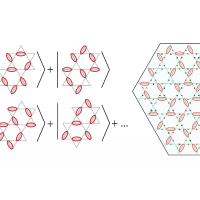News
The Harvard-MIT CUA collaboration led by Lukin, Greiner, and Vuletic reported the first experimental realization of a quantum spin liquid, a highly entangled phase of matter that eluded experimental observation for several decades. An example of topological state, such as a spin liquid, can help in the search for reliable quantum computers.
Predicted about 50 years ago by P. W. Anderson, quantum spin liquids are exotic phases of matter that have been a major focus of explorations in physical science for the past several decades. They feature the so-called topological order, in which the system’s properties are determined by its topology, as well as long-range quantum entanglement that can potentially be exploited to realize robust quantum computation.
The CUA physicists found a new way of experimentally probing this exotic phase of matter by using neutral atoms placed on frustrated lattices and controlling their mutual interactions by exciting them into Rydberg states. The onset of a quantum spin liquid phase was detected by measuring topological string operators that provide direct signatures of topological order and quantum correlations. They also performed a proof-of-concept test showing that this state can be used to encode topological quantum bits by putting the quantum spin liquids in special geometrical arrays with non-trivial topology. These observations enable the controlled experimental exploration of topological quantum matter and protected quantum information processing.
